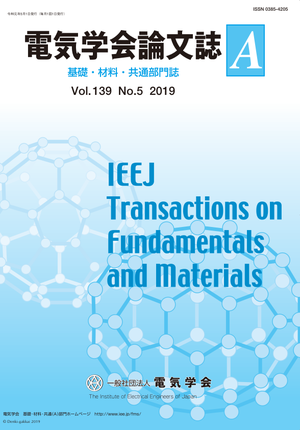ボウ・タイ状水トリーからの電気トリー発生メカニズムの検討
ボウ・タイ状水トリーからの電気トリー発生メカニズムの検討
カテゴリ: 論文誌(論文単位)
グループ名: 【A】基礎・材料・共通部門
発行日: 2019/05/01
タイトル(英語): Study of Inception Mechanism of Electrical Trees from Bow-tie Trees
著者名: 片貝 昭史(住友電気工業(株) 電線・エネルギー事業本部 電力事業部 開発部),日渡 重雄(住友電気工業(株) 電線・エネルギー事業本部 電力事業部 開発部),鈴木 弘(住友電気工業(株) 電線・エネルギー事業本部 電力事業部 開発部)
著者名(英語): Shoshi Katakai (Technology Development Department, Power Cable Division, Electric Wire & Cable Energy Business Unit, SUMITOMO ELECTRIC INDUSTRIES, LTD.), Shigeo Hiwatashi (Technology Development Department, Power Cable Division, Electric Wire & Cable Energy Business Unit, SUMITOMO ELECTRIC INDUSTRIES, LTD.), Hiroshi Suzuki (Technology Development Department, Power Cable Division, Electric Wire & Cable Energy Business Unit, SUMITOMO ELECTRIC INDUSTRIES, LTD.)
キーワード: XLPEケーブル,ボウ・タイ状水トリー(BTT),電気トリー,絶縁破壊,誘電率,抵抗率 XLPE cable,bow-tie tree (BTT),electrical tree,breakdown,permittivity,resistivity
要約(英語): Water trees are generated and grow from the defects of XLPE cables when the cables are energized in the presence of water. The relationship between bow-tie tree (BTT, a kind of water tree) length and breakdown strength of XLPE cables was obtained experimentally, and the electrical stresses at the BTT tips and the inside of BTTs were calculated. Using these results, the inception mechanism of electrical trees from BTTs was studied. The electrical trees are generated from the inside of BTTs near the BTT tips in many cases. Assuming the model where the permittivity of the BTT varies near the BTT tip, it was verified that the stresses near the BTT tip, even inside the BTT, become as high as 50 kV/mm under the applied voltage where the breakdown occurs, in cases where the relative permittivity εr of the BTT is supposed to be 10. Conversely, we found experimentally that the tree inception stress inside the BTT weakened to 10-70 kV/mm. Therefore, it may be possible to explain that the electrical trees are generated from inside the BTT, quantitatively. Furthermore, we took into consideration that the resistivity decreases in the BTT as the permittivity increases in it. If the resistivity ρ of the BTT decreases under the order of 109-1011 Ω.cm, the stresses near the BTT tip become over 100 kV/mm. Therefore, if the resistivity ρ of the BTT decreases, the electrical trees seem to initiate easily from the BTT. In cases where the length of the BTT is shorter than 500 μm, the calculation results of the relationship between BTT length and residual breakdown voltage fit the experimental results when the relative permittivity εr of the BTT is supposed to be 80. The value of εr=80 seems to be too high actually, however, this result is considered to be caused by the equivalent phenomenon as if εr=80 is occurring because the resistivity of the BTT may decrease non-linearly to the order of 109 Ω.cm under the high electric fields.
本誌: 電気学会論文誌A(基礎・材料・共通部門誌) Vol.139 No.5 (2019)
本誌掲載ページ: 264-276 p
原稿種別: 論文/日本語
電子版へのリンク: https://www.jstage.jst.go.jp/article/ieejfms/139/5/139_264/_article/-char/ja/
受取状況を読み込めませんでした


